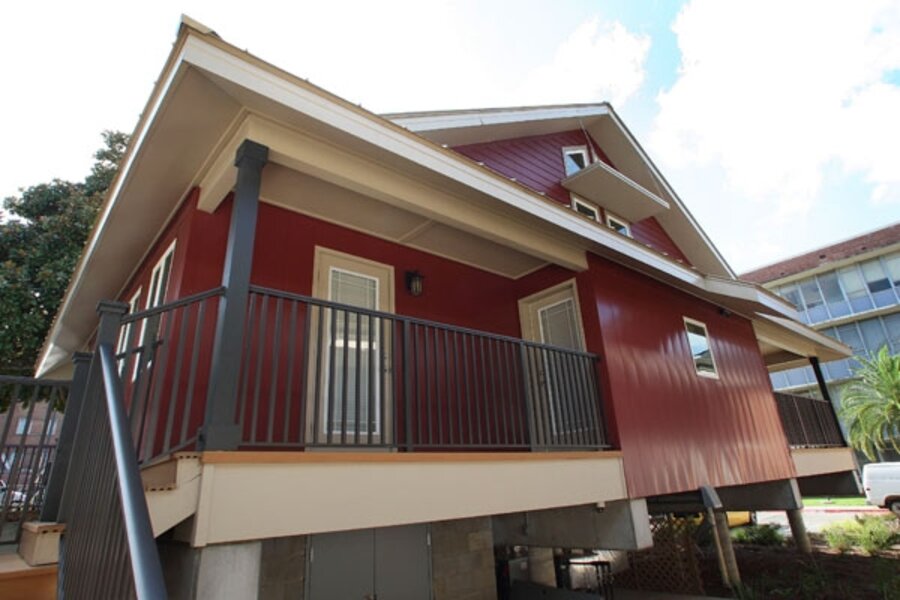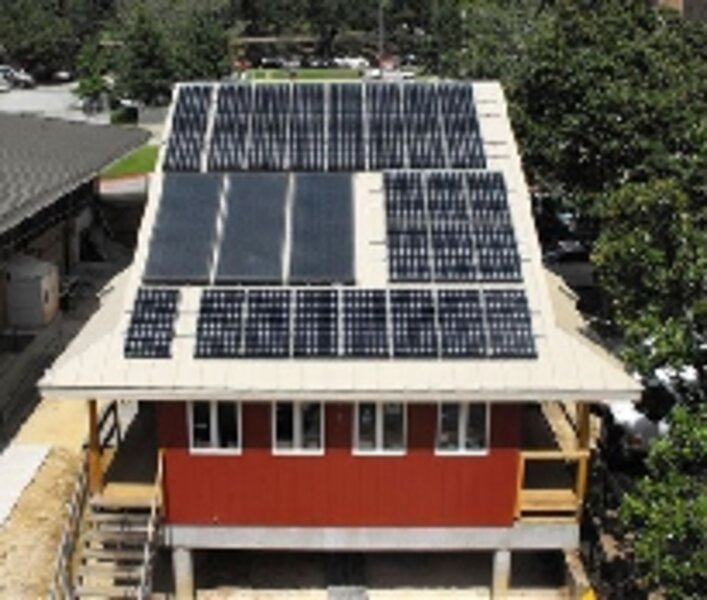Solar-hydrogen house in Florida combines new, old
Loading...
| TALLAHASSEE, Fla.
The elevated floor, tall ceilings, steeply pitched roof and broad overhangs are borrowed from the traditional "cracker house" that relied on shade and air movement for relief from Florida's sultry subtropical climate.
A pair of magnolia trees, dark red siding, ceiling fans, bamboo flooring, and rustic wooden beams salvaged from a Georgia barn add to the inviting atmosphere of the little house in the middle of Florida State University's brick-and-mortar campus.
It may look like an out-of-place throwback, but the $575,000 Off-Grid, Zero Emissions Building — OGZEB — has a futuristic purpose. Its mission is to test potential solutions to the world's energy and climate change problems by combining old tricks with cutting-edge technology, including a unique solar-hydrogen experiment.
"What we're trying to do is create the building of tomorrow with a lot of the feel of today," says project manager Justin Kramer. "If nobody wanted to live in it, what's the point?"
Like a 19th century cracker house, there are no power lines.
Solar panels on the roof are one of the few hints that the two-bedroom home is not a relic of the past. Solar panels have been popping up on rooftops around the country this year, in part because of an expanded federal subsidy that pays for 30 percent of the cost. States, including Florida, offer additional tax credits and incentives that further drive down the cost.
With Florida State's off-grid house, part of the electrical energy they produce is used to turn water into hydrogen for power when the sun isn't shining.
Dedicated in August, OGZEB has a couple small offices, but most of the interior, including an expansive living-dining-kitchen area, is strictly residential. Graduate students, staffers, and VIPs will take turns living there to give old and emerging technologies alike a real world tryout.
"If it's not being lived in and used, we're not getting good data," Mr. Kramer says.
Similar experiments are being done elsewhere, but what sets Florida State's effort apart from most is the building's reliance on hydrogen for power at night and on cloudy or rainy days.
Hydrogen is a potential low-cost alternative to batteries because storage tanks for the lighter-than-air gas are comparatively simple and cheap.
"It's a viable concept that they are demonstrating," says Yogi Goswami, co-director of the Clean Energy Research Center at the University of South Florida. "For hydrogen the problem is the cost of production. It's usually high. If they are going to reduce that cost, that's moving in the right direction."
Florida State scientists think they have a solution, Kramer says. They've developed a way to use relatively cheap and common metals to replace platinum, a critical but rare and high-priced element that makes hydrogen from water electrolysis devices expensive.
Perfecting that technology is going to take more time and money so the house is starting with an off-the-shelf version that uses traditional platinum electrodes, Kramer said.
To make a sufficient amount of hydrogen, the house needs a hefty array of photo voltaic solar panels. They produce 6.9 kilowatts of power compared to 1 or 2 kilowatts for a typical off-grid house of its size — 1,064 square feet, Kramer says.
Another innovative feature is how the hydrogen is used. Besides a hydrogen fuel cell to generate electricity, the gas is burned in the kitchen range and other appliances may follow.
"It's more efficient to combust hydrogen," Kramer says.
It also burns cleanly, emitting only water vapor and heat.
The problem is conventional appliances are designed for heavier natural gas and propane. They must be modified to safely burn hydrogen.
In a joint effort with the Viking Range Corp., Florida State researchers are transforming the house's kitchen stove. One step was to narrow the range-top jets because hydrogen packs more punch than natural gas.
It burns straight up instead of radiating so "you can actually hold your hand to the side of the flame for extended periods of time," Kramer said.
That also means hydrogen won't work in the radiant-heat oven. It's going to be converted to a convection oven that uses fans to circulate the heat.
Gas-burning refrigerators that once were fairly common have become rare for household use, but most recreational vehicles still have small propane versions. The house now has an electric refrigerator, but Kramer says the goal is to replace it with one powered by hydrogen, solar-heated water, or both.
Key hydrogen components are housed under the building in a concrete block and steel blast room.
"We've all seen the Hindenburg," Kramer says. "Goodness, that has brought all kinds of fun to my life as a hydrogen researcher."
Hydrogen, though, is relatively safe compared to natural gas as long as you aren't riding in an airship filled with it, Kramer says. Being so light, it diffuses rapidly instead of building up to catch fire like natural gas. Also, breathing it in won't suffocate you — it will just change your voice like inhaling helium.
"You would just talk in a high, annoying pitch," Kramer says.
Hydrogen power may be the ultimate goal, but it could take decades to perfect. In the meantime, the house is being used to demonstrate other technologies that can be applied right now or in just a few years. That includes the cracker house techniques that fell out of use with the arrival of air conditioning.
There are no plans to heat the home with hydrogen although that may be a good option for colder climates, Kramer says. Instead, it uses an electric and geothermal system that's very efficient in Tallahassee's mild climate. Researchers, though, may try to integrate the solar hot water and heating-air conditioning systems.
Besides photo voltaic panels producing electricity, the roof has a solar hot water array, an older but efficient technology. It's also oversized, heating enough water to 133 degrees to fill a 300-gallon tank beneath the house. That's more than enough for bathing and dish washing. The excess will be used to test future applications such as the heating-air conditioning system and refrigerator.
Simple light shelves under the upper windows reflect incoming sunshine and spread it evenly to avoid hot spots. Other energy-saving technologies include a reflective roof, dual-flush toilets and recycled material such as the wooden beams and trim, aluminum siding and ash in the concrete pilings.
The house is bolted together with large, double sheets of oriented strand board sandwiched around foam insulation. That eliminates the need for most studs, which transfer outdoor heat into a house, Kramer says.
"This house is designed to be torn apart and put back together as new technologies are developed," Kramer says. "We want to took at today and tomorrow at the same time.
Editor’s note: For more articles about the environment, see the Monitor’s main environment page, which offers information on many environment topics. Also, check out our Bright Green blog archive and our RSS feed.






